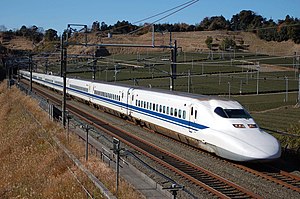700 Series Shinkansen
| 700 series | |
|---|---|

A 700 series train on the Tokaido Shinkansen between Kakegawa and Shizuoka in January 2008
|
|
| In service | 1999–Present |
| Manufacturer | Hitachi, Kawasaki Heavy Industries, Kinki Sharyo, Nippon Sharyo |
| Replaced | 0 series, 100 series, 300 series |
| Constructed | 1997–2006 |
| Scrapped | 2012– |
| Number built | 1,328 vehicles (91 sets) |
| Number in service | 912 vehicles (65 sets) (As of 1 April 2016[update]) |
| Number preserved | 1 vehicle |
| Number scrapped | 415 vehicles (26 sets) |
| Formation | 8/16 cars per trainset |
| Capacity | 16-car sets: 1,323 (200 Green + 1,123 Standard) 8-car sets: 571 |
| Operator(s) |
|
| Depot(s) | Tokyo, Osaka, Hakata |
| Line(s) served | Tokaido Shinkansen, Sanyo Shinkansen, Hakata-Minami Line |
| Specifications | |
| Car body construction | Aluminium |
| Car length | 25,000 mm (82 ft 0 in) (intermediate cars), 27,350 mm (89 ft 9 in) (end cars) |
| Width | 3,380 mm (11 ft 1 in) |
| Height | 3,690 mm (12 ft 1 in) |
| Doors | 2 per side |
| Maximum speed | 270 km/h (170 mph) (Tokaido), 285 km/h (177 mph) (Sanyo) |
| Traction system | 48 x 275 kW (369 hp) (16-car set), 24 x 275 kW (369 hp) (8-car set) |
| Power output | 13.2 MW (17,700 hp) (16-car set), 6.6 MW (8,900 hp) (8-car set) |
| Acceleration | 2.0 km/h/s (0.56 m·s−2) |
| Deceleration | 2.7 km/h/s (0.75 m·s−2) |
| Electric system(s) | 25 kV AC, 60 Hz overhead catenary |
| Current collection method | Pantograph |
| Safety system(s) | ATC-1, ATC-NS |
| Track gauge | 1,435 mm (4 ft 8 1⁄2 in) |
The 700 series (700系 Nanahyaku-kei?) is a Japanese Shinkansen high-speed train type built between 1997 and 2006, and entering service in 1999. Originally designated as "N300" during the development phase, they formed the next generation of shinkansen vehicles jointly designed by JR Central and JR-West for use on both Tokaido and Sanyo Shinkansen lines.
The 700 series is characterized by its flat 'duck-bill' nose designed to reduce the piston effect as the trains enter tunnels. 16-car units are painted white with blue stripes beneath the windows, and are used for Nozomi, Hikari, and Kodama services on the Tokaido and Sanyo Shinkansen lines, while 8-car units used for the Sanyo Shinkansen Hikari Rail Star services have a darker livery (grey with black window areas and a yellow stripe beneath the windows) which also acts to visually deemphasize the units' nose area, resulting in a more streamlined impression.
As with the 500 series trains, yaw dampers are fitted between vehicles, and all cars feature semi-active suspension to ensure smooth ride characteristics at high speed. Compared with the small fleet of high-performance, high-cost 500 series trains built for JR-West, these trains were designed to give improved ride comfort and interior ambience over the earlier 300 series trains at a lower cost than the 500 series trains. The cost of a 16-car 700 series unit is approximately 4 billion yen compared with around 5 billion yen for a 16-car 500 series train.
...
Wikipedia
